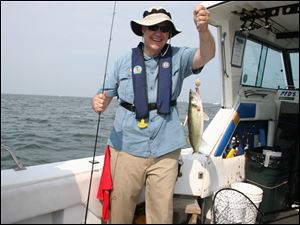
Groups take issue with proposed Lake Erie withdrawals
4/12/2012
David Mustine, former ODNR director, displays a Lake Erie walleye he caught aboard Sea Breeze Sixteen last summer during the 33rd annual Governor's Fish Ohio Day promotion at Port Clinton.
COLUMBUS — The latest stab at legislation controlling withdrawals of water from Lake Erie could endanger the health of rivers and streams that feed it and further erode lake tourism, environmental and sportsmen groups argued Thursday.
Paul Pacholsky, vice president of Lake Erie Charter Boat Captains, said the number of captains on the lake was down from 1,200 to 750 last year. He fears it could be as low as 700 this season, and he attributes at least part of that to worsening algal blooms.
“Most people who come off the boats rebook for the following year,” he said. “A lot of people in August through October looked at the water and said, ‘We’ll call you about next year,’ and the phones aren’t ringing.”
Gov. John Kasich last year vetoed Ohio lawmakers’ first attempt at writing between the lines of the Great Lakes-St. Lawrence River Basin Water Resources Compact approved by eight states and Congress. That business-backed bill drew criticism from other states, two of Mr. Kasich’s gubernatorial predecessors, and environmental groups, in part, because it would have set the most lenient thresholds for water withdrawals of any of the Great Lakes states.
The new bill roughly halves the proposed thresholds before a power plant, steel mill, manufacturer, farm, golf course, amusement park, or other user may withdraw water before having to get a state permit. This time around, the more competitive thresholds aren’t the source of opposition.
The National Wildlife Federation, Izaak Walton League, and the boat captains objected to language in the bill that addresses the impact of water withdrawal from the river basin and not on the inland tributaries that replenish it.
“The tributaries for Lake Erie, in particular, provide certain critical habitat for a number of species,” said Rick Graham, Ohio division president of the Izaak Walton League. “Steelhead, walleye, and smallmouth bass are all important issues to Lake Erie and also to the people for fish for them … .”
They voiced concern that users could withdraw water from inland lakes, streams, and rivers at a faster rate than it can be replaced, particularly during drier summer months.
House Bill 473 is sponsored by Rep. Lynn Wachtmann (R., Napoleon) and backed by such groups as the Ohio, Toledo, and Cleveland chambers of commerce; large farms; and the oil, chemical, soft drink, and mining industries.
Its supporters, angered by Mr. Kasich’s veto of their last attempt, have argued that the vast majority of water taken by businesses is returned to the watershed. They argue that Ohio businesses must be able to count on sustainable water sources.
The bill would allow users to consume up to 2.5 million gallons of water a day directly from the lake without having to get a permit. They could take 1 million gallons from groundwater, rivers, streams, and other inland sources within the watershed covering roughly the northern third of Ohio and 100,000 from streams determined to be of high quality.
The daily use levels would be averaged over a 90-day period, in line with what Indiana and Pennsylvania have adopted. Other Great Lakes states average over shorter periods of time. Even the Kasich administration has asked the House Agriculture and Natural Resources Committee considering the bill to remove the 90-day averaging language for high-quality streams.